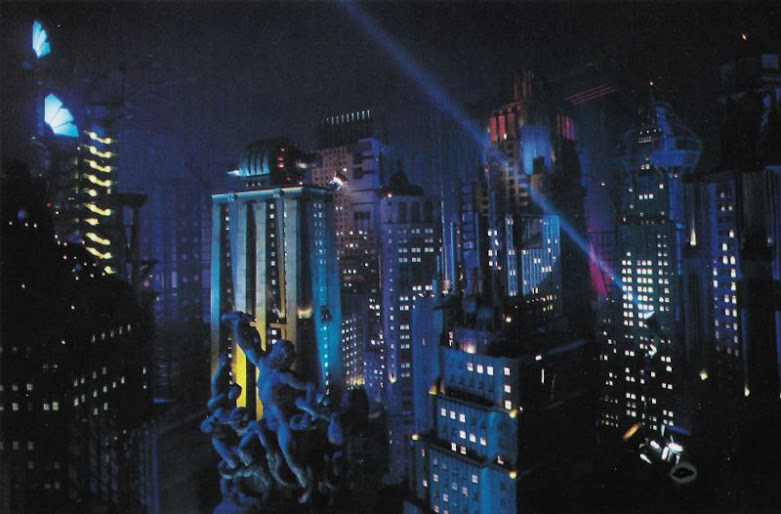Here's a fantastic article on the effects work and miniatures used in Batman Forever. It gets a little technical but I think you'll find it really interesting regardless. Due to the tiny text size, landscape format and small images I've edited this so that it's easily readable and the images are nice and big.
I'm going to split this up over three posts.
 |
In Batman Forever –
Warner Brothers' third instalment in its comic book franchise – the
directorial reins were transferred from Tim Burton to Joel
Schumacher, who brought a lighter touch to the proceedings .
Significant changes included the casting of Val Kilmer – replacing
Michael Keaton as the mysterious Caped Crusader – and the
introduction of Robin to the series. Also introduced were a new
batmobile and a redesigned batcave, erected in a giant Long Beach
dome hangar that formerly housed the Spruce Goose.
|
 |
Adding campy villainy
to the production were Jim Carrey as the diabolical Riddler, a
techno-nerd turned criminal mastermind, whose chief pleasure is
derived from taunting his victims with obscure riddles; and Tommy Lee
Jones as Two-Face, former district attorney turned deranged crook
whose facial features are hideously acid-scarred on one side while
perfectly normal on the other. Appliance for the character was
designed by Rick Baker.
|


 |
Expansive miniature
sets, filmed motion control under the supervision of Boyd Shermis and
Eric Dust, were combined with computer generated imagery, matte
paintings, full-scale set pieces and location footage to create a
complex, cosmopolitan Gotham City. Modelmakers working under
supervisor Michael Joyce constructed several large set pieces from
scratch, as well as pressing into service a number of miniature
skyscrapers original built by Stetson Visual Services for The
Hudsucker Proxy. The existing miniatures required extensive
restoration and detailing to accommodate the retrofit design motif of
the film.
|
 |
A motion control camera
moves through the Gotham city set, smoked to create aerial density
and lit with splashes of comic book colour.
|
 |
A nocturnal beauty shot
reveals a sampling of the ubiquitous giant statuary incorporated into
the cityscape.
|
 |
A habour statue of Lady
Gotham was sculpted, photographed by itself and matted into the
cityscape as needed. Modelmaker Pete Gerard installs a rotating
searchlight in the statue's torch.
|
 |
Modelmaker Kento Gebo
wires miniature fluorescent lights for the translight surface of a
Gotham City sign, one of many incorporated into the miniature
environment.
|
 |
Giant statues carved
out of foam were among the surreal elements embellishing the urban
landscape of the miniature Gotham set. A sculpting team, headed by
Yarek Alfer created most of the massive figures.
|
 |
Having foiled a bank
heist staged by Two-Face primarily to entrap him. Batman finds
himself clinging periously to a chain attached to a careening
helicopter. As darkness approaches, effects crew members prepare for
a night shot in which the helicopter – a model tail-mounted on a
rod extending from a linear track – smashes through an eye-shaped
billboard.
|
 |
The billboard miniature
made from tempered glass rigged with pyrotechnic charges – shatters
moments before impact.
|
 |
In post-production,
Pacific Data Images replaced rotors on the model helicopter with
digital alternates that produced a superior motion blur. PDI also
incorporated digital neon into the sign and added a computer
generated Batman dangling from the chopper and motion-traced to the
shot.
|




















No comments:
Post a Comment